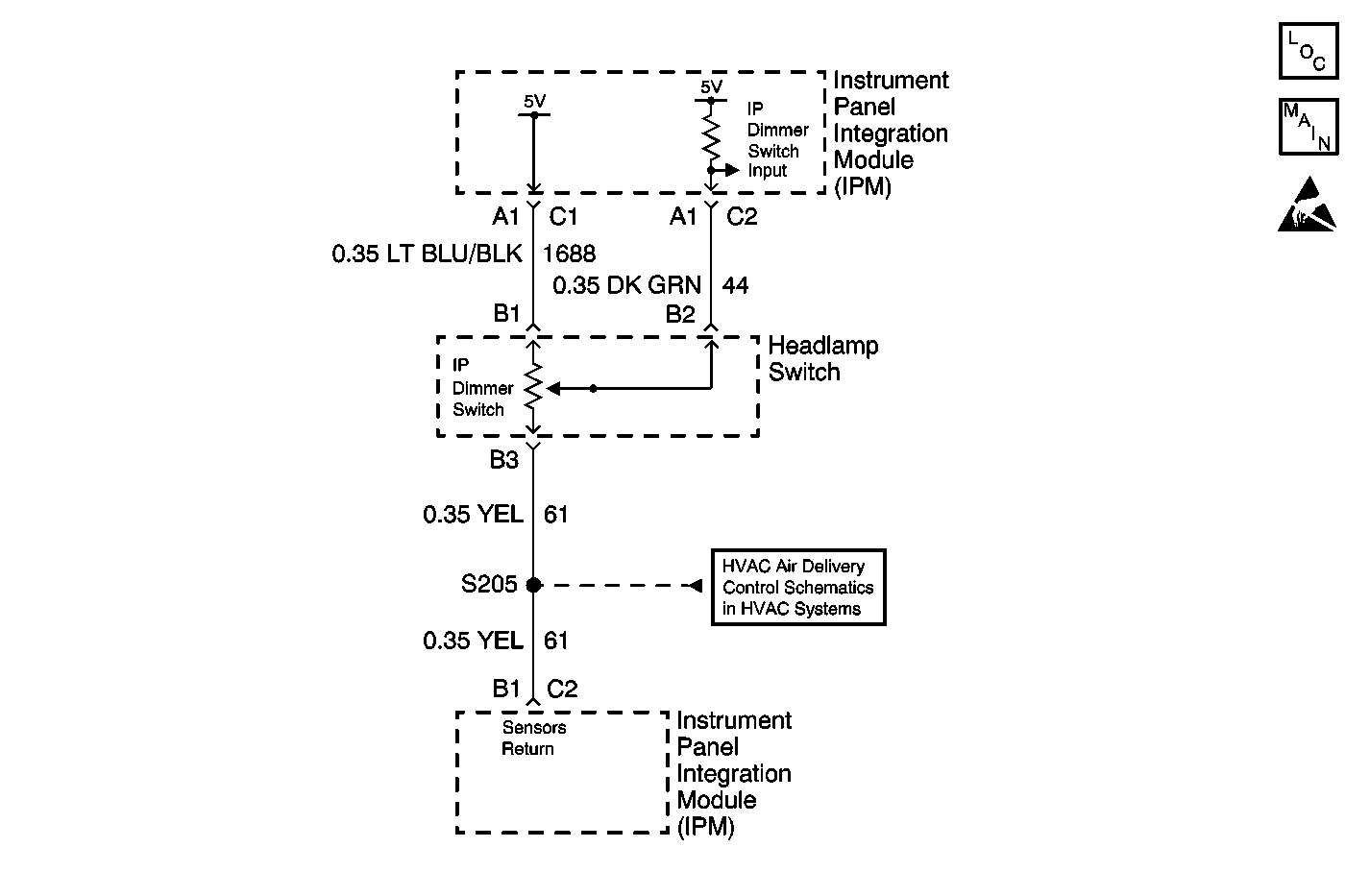
Circuit Description
The interior lamp rheostat is a potentiometer. The Instrument Panel Integration Module (IPM) determines the control setting based on the voltage from the interior lamp rheostat. The IPM sends out a class 2 message to the dash integration (DIM) module. The intensity of the IP backlighting shall be adjustable whenever the park lamps are on. The intensity of the vacuum florescent displays shall only be adjustable when it is night and the park lamps are active.
Conditions for Running the DTC
This test is run every 150 milliseconds.
Conditions for Setting the DTC
The interior lamp rheostat voltage is less than 0.09V or greater than 4.75V on 3 consecutive tests.
Action Taken When the DTC Sets
Set dimming level to full brightness for all displays.
Conditions for Clearing the MIL/DTC
The IPM does not detect a voltage that is less than or greater than the predetermined value during the diagnostic self test.
Diagnostic Aids
| • | The following may cause an intermittent: |
| - | Bent terminal |
| - | Backed out terminal |
| - | Damaged terminal |
| - | Poor terminal tension |
| - | Chafed wire |
| - | Broken wire inside the insulation |
| • | When diagnosing for an intermittent short or an open, manipulate the wire harness while watching the test equipment for changes. |
Test Description
The numbers below refer to the step numbers on the diagnostic table.
-
Tests for the proper operation of the circuit in the high voltage range.
-
Tests for the proper operation of the circuit in the low voltage range. If the fuse in the jumper opens when you perform this test, the signal circuit is shorted to voltage.
-
Tests for a short to ground in the 5 volt reference circuit.
Step | Action | Value(s) | Yes | No |
|---|---|---|---|---|
1 | Did you perform the Lighting Systems Diagnostic System Check? | -- | Go to Step 2 | |
2 |
Does the scan tool indicate that the Interior Dim Pot data parameter is within the specified range? | 0.09-4.8 V | Go to Diagnostic Aids | Go to Step 3 |
Does the scan tool indicate that the Interior Dim Pot data parameter is greater than the specified value? | 4.8 V | Go to Step 4 | Go to Step 8 | |
Does the scan tool indicate that the Interior Dim Pot data parameter is less than the specified value? | 0.09 V | Go to Step 5 | Go to Step 9 | |
Does the scan tool indicate that the Interior Dim Pot data parameter is greater than the specified value? | 4.8 V | Go to Step 7 | Go to Step 6 | |
6 | Test the 5 volt reference circuit of the IP dimmer switch for a short to ground. Refer to Circuit Testing and Wiring Repairs in Wiring Systems. Did you find and correct the condition? | -- | Go to Step 15 | Go to Step 12 |
7 | Test the 5 volt reference circuit of the IP dimmer switch for a short to voltage, a high resistance, or an open. Refer to Circuit Testing and Wiring Repairs in Wiring Systems. Did you find and correct the condition? | -- | Go to Step 15 | Go to Step 11 |
8 | Test the signal circuit of the IP dimmer switch for a short to ground. Refer to Circuit Testing and Wiring Repairs in Wiring Systems. Did you find and correct the condition? | -- | Go to Step 15 | Go to Step 12 |
9 | Test the signal circuit of the IP dimmer switch for a short to voltage, a high resistance, or an open. Refer to Circuit Testing and Wiring Repairs in Wiring Systems. Did you find and correct the condition? | -- | Go to Step 15 | Go to Step 10 |
10 | Test the sensors return circuit of the IP dimmer switch for a high resistance or an open. Refer to Circuit Testing and Wiring Repairs in Wiring Systems. Did you find and correct the condition? | -- | Go to Step 15 | Go to Step 12 |
11 | Inspect for poor connections at the harness connector of the headlamp switch. Refer to Testing for Intermittent Conditions and Poor Connections and Connector Repairs in Wiring Systems. Did you find and correct the condition? | -- | Go to Step 15 | Go to Step 13 |
12 | Inspect for poor connections at the harness connector of the instrument panel integration module (IPM). Refer to Testing for Intermittent Conditions and Poor Connections and Connector Repairs in Wiring Systems. Did you find and correct the condition? | -- | Go to Step 15 | Go to Step 14 |
13 | Replace the headlamp switch. Refer to Headlamp Switch Replacement in Lighting Systems. Did you complete the replacement? | -- | Go to Step 15 | -- |
14 | Replace the instrument panel integration module (IPM). Refer to Instrument Panel Module Replacement in Body Control System. Did you complete the replacement? | -- | Go to Step 15 | -- |
15 |
Does the DTC reset? | -- | Go to Step 2 | System OK |
